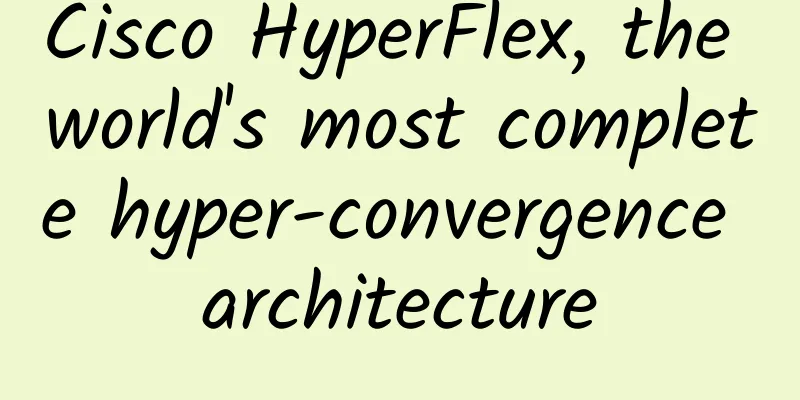Cisco HyperFlex, the world's most complete hyper-convergence architecture

|
[51CTO.com original article] Hyper-convergence is a hot topic right now. As a leading manufacturer in the field of hyper-convergence, 51CTO interviewed Cisco. The reporter invited Mr. Zhu Lixin, Vice President of Cisco Greater China and General Manager of Product Department, to talk about Cisco's hyper-convergence product HyperFlex. Hyper-Converged Infrastructure (HCI), also known as hyper-converged architecture, means that the same set of unit equipment (x86 server) not only has computing, networking, storage and server virtualization resources and technologies, but also includes cache acceleration, data deduplication, online data compression, backup software, snapshot technology and other elements. Multiple nodes can be aggregated through the network to achieve modular seamless horizontal expansion (scale-out) to form a unified resource pool. If you want to learn more about Cisco HyperFlex Cisco HyperFlex provides a stable and high-performance hyper-converged system for virtual machines The following is the interview transcript:
1. Hyper-convergence is very popular now. How is Cisco's hyper-convergence product HyperFlex? Answer: Cisco HyperFlex has performed very well in the market. One year after the product was launched, it has more than 1,100 customers. The speed of market acceptance is rare in the history of Cisco products. 2. Cisco HyperFlex is selling well. What do you think is its biggest advantage? Answer: Completeness. Cisco HyperFlex integrates computing, networking, and storage into a fully integrated, factory-installed, out-of-the-box platform. Completeness provides customers with rich value: excellent performance, one-stop service, and standardized quality. These problems that have plagued customers' IT operations and maintenance for many years are solved. 3. I understand that Cisco HyperFlex integrity is about integrating the network into hyper-convergence, right? A: Yes, that’s why Cisco calls HyperFlex the second generation of hyper-convergence, because the first generation of hyper-convergence only integrates servers and storage. The hyper-convergence network must first select a low-latency, high-bandwidth switch that is suitable for hyper-convergence needs, and secondly, it must be able to cooperate with the server to support priority control to ensure the bandwidth of storage I/O. 4. I understand the advantages of the complete one-stop service and standardized quality you mentioned just now, but how do you understand excellent performance? A: The biggest difference between hyper-convergence and traditional architecture is that data is distributed, so its performance involves many factors, such as hardware configuration, distributed storage software performance, network bandwidth and latency. ESG, a third-party evaluation company, has just completed a comprehensive evaluation, and the performance of Cisco HyperFlex is 2-3 times higher than that of its competitors, which is amazing. 5. We believe HyperFlex will have many advantages. After integrity and high performance, which advantage would you put in the third place? A: Deduplication and compression. Hyper-convergence data protection is a copy method, 2 or 3 copies, which means that the disk utilization rate of hyper-convergence is only 33%. Users buy 100TB disks but only 33TB of capacity is available, which is a huge waste. Cisco HyperFlex took this issue into consideration when it was first designed, so we built-in deduplication and compression functions. We were surprised to find that HyperFlex's deduplication and compression achieved a high efficiency of 3:1 or 4:1 in the actual user environment. That is, the user's 3TB or 4TB of data only consumes 1TB of disk, while maintaining excellent performance. 6. The last question is that flash memory replacing disks seems to be an inevitable trend. How does HyperFlex support all-flash memory? A: Yes, flash memory replacing disk is an inevitable trend, so the focus of this release of HyperFlex 2.0 is all-flash memory. The hyper-convergence performance of the HyperFlex all-flash memory model has been improved by 6 times on the basis of the existing hybrid model. All-flash memory has many new technical points, but I will not elaborate on them due to time constraints. [51CTO original article, please indicate the original author and source as 51CTO.com when reprinting on partner sites] |
>>: Ruijie-style innovation: Ruijie Networks 2017 product and solution strategy released in Beijing
Recommend
China? The United States? South Korea? Which country has the strongest 5G private network application development in the world?
As an important driving force for the digital tra...
It’s the beginning of the new school year again. Operators’ “5G+” builds a solid line of defense for campus security
It's the start of another school year. China ...
Explore the unlimited potential of 5G technology
Information technology experts and economists hav...
What does the battle for AI spectrum mean for 5G?
With the rapid development of smart cities, every...
10 Useful HTML File Upload Tips
[[351004]] The ability to upload files is a key r...
5G RedCap: New Cellular IoT Technology Optimization
The latest version of the 3GPP standard for mobil...
China's first ISO/IEC artificial intelligence international standard project was approved
In August this year, the AI data quality intern...
CloudSilk VPS in Tokyo, Japan is now online, with annual payment of CMI for three-network backhaul starting from 360 yuan
CloudSilk has launched a VPS host in Tokyo, Japan...
The 5G commercial license has just been officially issued! Here are ten issues that you should pay attention to
On the morning of June 6, the Ministry of Industr...
Talk about the communication protocol I2C subsystem Hs Mode
1. I2C Hs-mode Why is HS mode explained separatel...
South Korea's 5G penetration rate is close to 10%, 14 times that of China, and the United States' 5G penetration rate is 0.63%.
The Ministry of Science and ICT of South Korea re...
5G is here, and you can’t hide from it
5G has gradually entered our lives with the resea...
5G brings devastating impact, ten physical industries will disappear in 22 years
5G has brought a devastating impact, and ten more...
Alibaba Cloud Server Special Offer, Personal Cloud Server as low as 0.95% off, annual payment starting from 96 yuan
Various promotional activities are being carried ...
2020 is already halfway through, how far is 5G from a full-scale outbreak?
In 2019, we often heard the industry say that 201...









